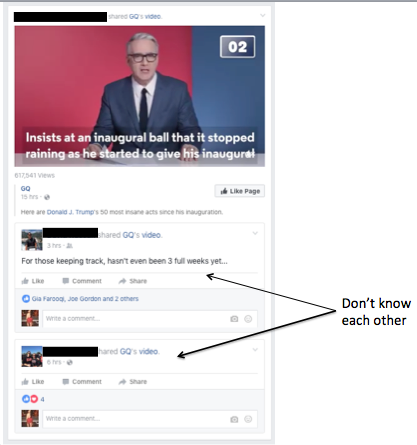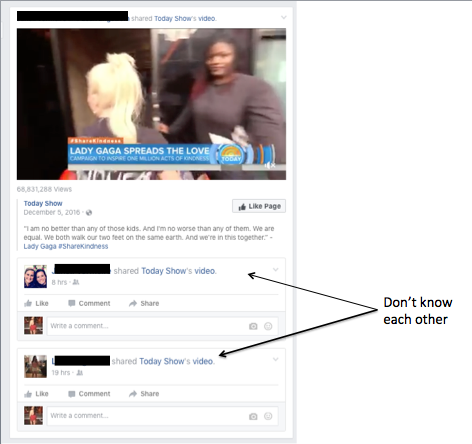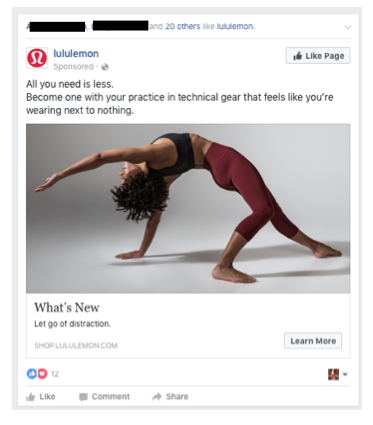As tired as we are of hearing about it, we cannot go on to any form of social media without seeing something about politics. We read these links that friends share, or at the very least glance at them and continue to scroll—but in the back of our heads perhaps we agree with them.
If we look at our network on social media, how many people do you overlap with on Instagram, Facebook, Twitter, Snapchat, etc? Chances are you have at least a few people that you follow on all platforms. Despite the fact that we think we have so many followers and friends on these platforms we have to think back to the earlier part of the semester where we learned about the different type of social media users—there are people that “live” on the social media platform, and make it their home by sharing, commenting, posting new statuses; and then there are people who just visit, maybe just leaving a small train of Facebook “reactions” behind—but that is how they treat the platform. Because our friends and followers is a specific amount (but can fluctuate), the likelihood of us seeing the same accounts post over and over is high. So what?
In chapter 9 of Humphrey’s text, they claim “people are more likely to form social ties with those who are like them on some dimension” (156). Okay, sure. If you like someone you are a little more likely to follow that person on social media. We all have those moments that we met our best friend’s cousin at a barbeque last summer and after the party they added you on Facebook—you liked them enough, and they were similar enough to you, that you felt comfortable adding them to your social network. So now on a platform like Facebook, you have a network of friends from all over the place, but have you ever seen the same “Tasty” article, or newest political issue being shared multiple times on your newsfeed by people not even in the same friend group? I have. As I said before, Humphrey claims that we often are friends with likeminded people on our social media platforms, we practice homophily. Which in Humphrey’s words is “the tendency to form homophilous ties means that we have close ties with people who think and act a lot like we do” (156). Humphrey says because we as human beings naturally practice homophily, this is the reason “why when you sign online you may see five people who have chose to share the same point of view on the latest news scandal. Homophily means that we often end up “preaching to the choir” on social media” (156).
I went on my Facebook as I wrote this blog to see if I could find any instances where people from totally different friend groups “liked” or “shared” the same thing. And this is what I found:
In this picture two guys I know shared the same GQ video. One of the guys I graduated high school with, and one I worked with when I used to lifeguard. Both different ages, different friend groups, different everything—the only similar thing is that they grew up in two towns that are right next to each other—so the chances of them having someone in common in their closer network is possible. Regardless as to whether or not they do have a common connection aside from me, they still shared the same video. This is because in my network of friends, mine tend to lean more towards the left wing, and since we are all somewhat like-minded, the likelihood of content being shared increases. This is the case for many people on my Facebook.

This picture is a screenshot of a similar instance. Except one girl I went to high school with but she was a year below me and we were not that close, and the other girl is a friend I worked with at summer. They both shared the Today Show’s video of Lady Gaga. Similar to the guys, they have similar views but their only common connection is myself. We are in some ways all one network, and are all connected, even though we may not know each other directly.

The last instance I noticed was on the sponsored page by Lulu Lemon, over twenty girls I know liked the page, but I never did despite the fact that I have owned Lulu, my network on Facebook was a large enough “liker” of the page to suggest it to me through a sponsored ad.

Overall I think that Humphrey proves a good point. Despite the fact that we think we have so many different kinds of followers, friends, and perhaps acquaintances on Facebook, the chances are you have something in common—we are attracted to those who are like us. I think it is important that we keep this in mind. We see the same people posting over and over, chances are is that our newsfeed is filled daily by the same group of people in our friend network. It can be a good thing that we always have that one friend who posts dog or cat videos every day, but we also have to remember with more critical things like politics, our social feeds are a bunch of likeminded bubbles–and we have to make sure we pop them by extending our knowledge beyond our feed.



